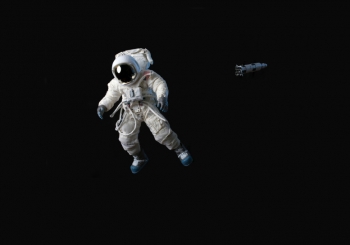If you were to ask a classroom of second graders who want to be an astronaut, then chances are that half of the children will raise their hand. And if you are lucky enough to have a real astronaut in front of the class telling about his adventures, it is more than likely that everyone will do so – including the teacher. The appealing factor of space travel to these kids (besides the adventure, obviously) is that special situation that is almost impossible to experience anywhere on earth: zero gravity! What is so attractive about zero gravity? Floating off course!
By Rob van den Berg, director Space Expo Noordwijk
Now that I think about it, there is something peculiar about this familiar phenomenon course that we call gravity. There are countless natural phenomena that we praise for their beautiful, pleasant or special qualities. Think of an endless blue sky, a beautiful sunset, the alternation of the seasons, a full moon, a sky filled with stars on a clear night, and so on. Even natural disasters get some acclaim, even if it is just some recognition of their destructive power or their gigantic magnitude. Only the ubiquitous gravity is being left out. I do not know of a single poem about the beauty of gravity, nor have I ever heard of a painting with gravity as its central theme. It is, however, a natural phenomenon whose very absence makes us happy.
For several years now, Space Expo features a life-sized model of two modules of the International Space Station. Most children who walk through it pretend like they are floating. The most common question is where they can find the button to turn the gravity off. Can you actually turn off gravity? Divers enjoy an apparent weightlessness, like gliders and hang gliders. But moving freely in three dimensions is different from weightlessness.
Still, it is not that difficult to momentarily escape the gravity on earth. You just need to jump. Once your feet are off the ground, so while you are still in the process of going up, you have been weightless. A trampoline is a useful instrument to experience this. In an airplane making a parabolic flight it takes even less imagination to sense the absence of gravity. ESA and NASA use these flights to train their astronauts to work under weightless conditions. The nickname of the planes performing these manoeuvres – vomit comets – indicate that it is not always a pleasant experience.
Weightlessness is the same thing as falling – with the added bonus of not hitting the ground. This also applies to astronauts in orbit around Earth. At school I learned that with the right orbital speed, gravity remains in an exact equilibrium with the force that is trying to fling the astronauts out of orbit, the centrifugal force. But what really happens is that the astronauts are continuously falling.
Fortunately, our planet is not flat, but sphere shaped, which allows the astronauts to continue falling around the earth instead of moving an inch closer to the ground. Therefore, instead of carelessly floating through their spacecraft, astronauts feel as if the soil is washed away from under their feet, provoking them to experience their orbit around our planet a tumble in a bottomless pit.
To most people, floating in space suddenly seems a lot less attractive. But fortunately this is not the case for everyone, given the large number of candidates on the rare occasions that they have a job application asking for new astronauts. Or, as a seemingly emancipated astronaut said to his female colleague in training: “I can imagine why you want to become an astronaut. Isn’t that is the dream of every woman, weightlessness?”
